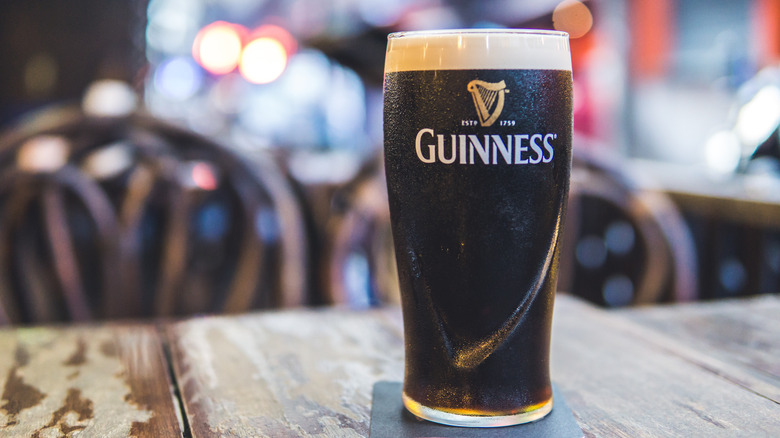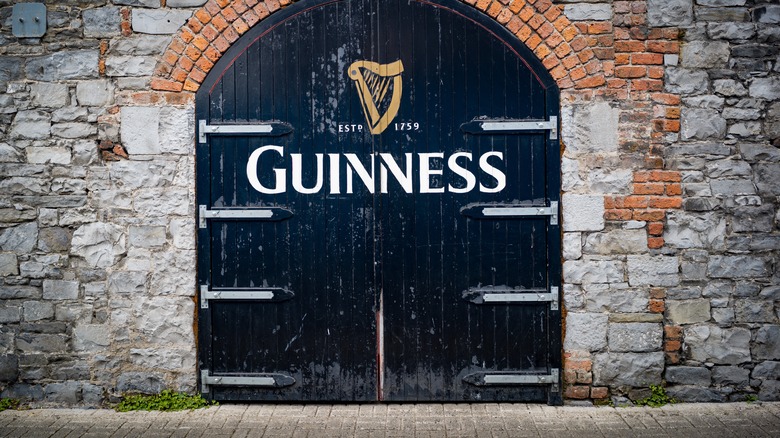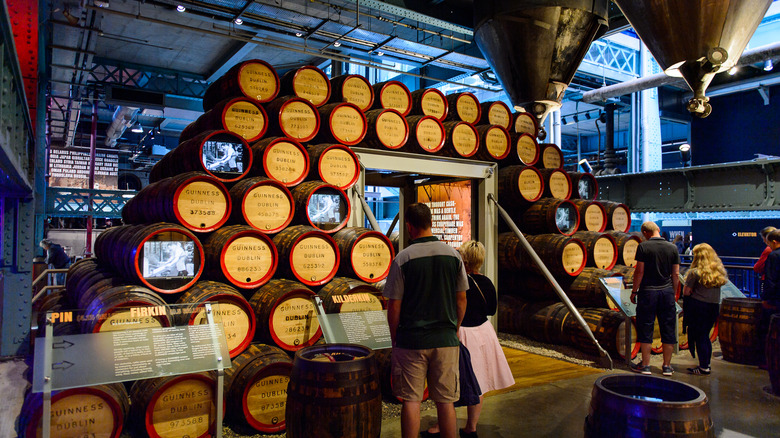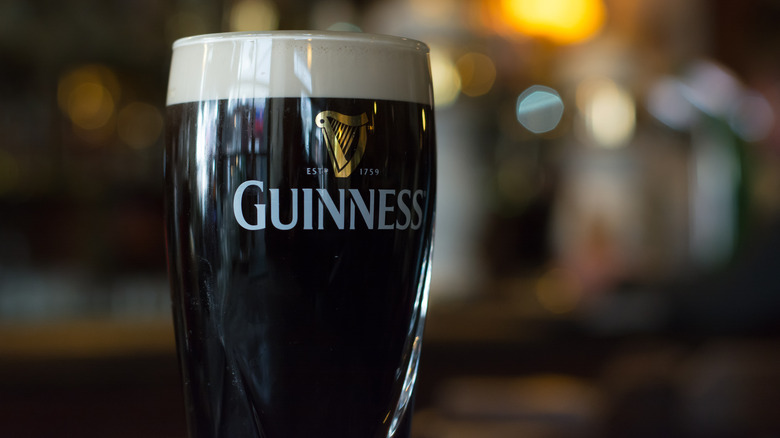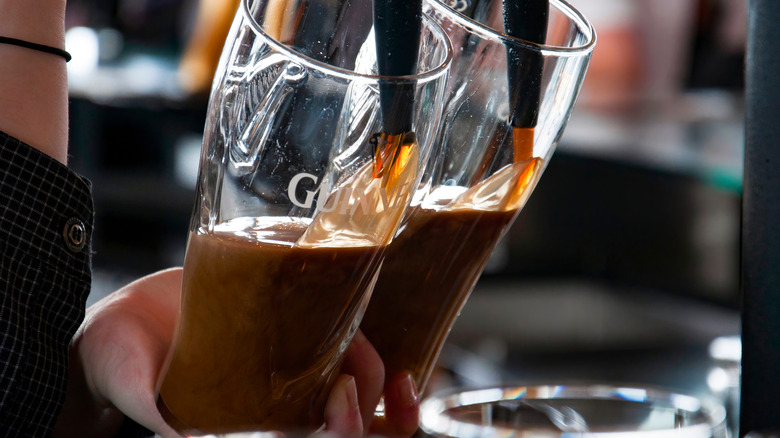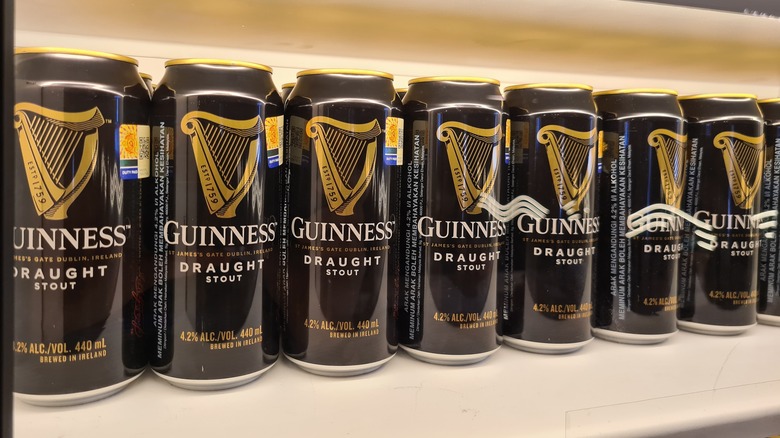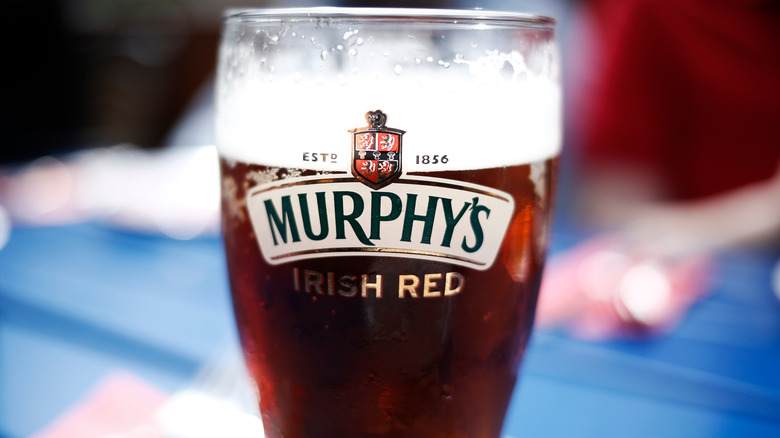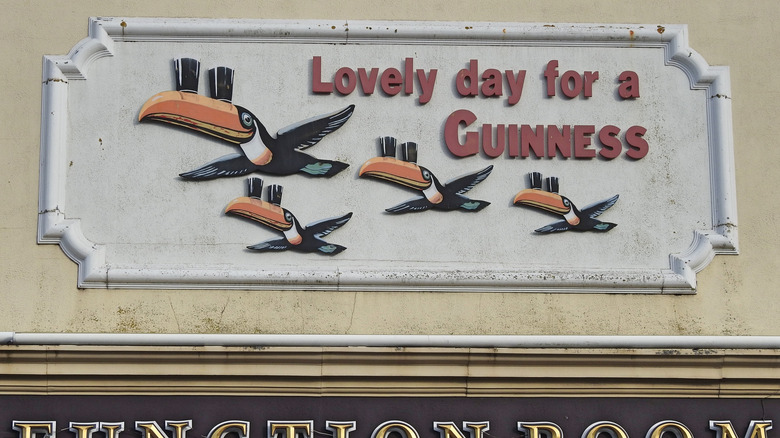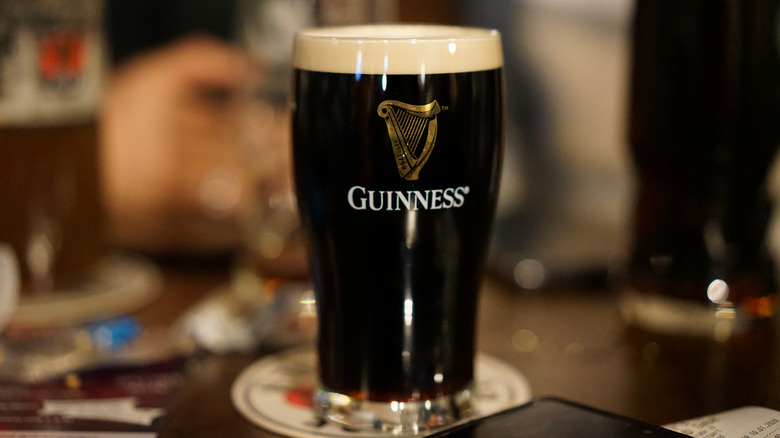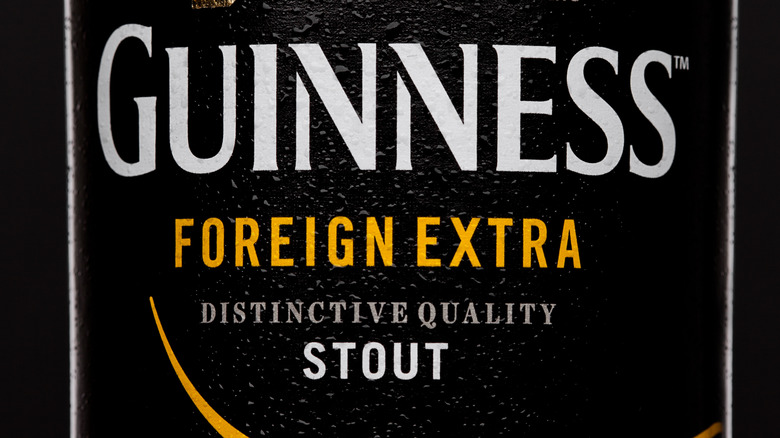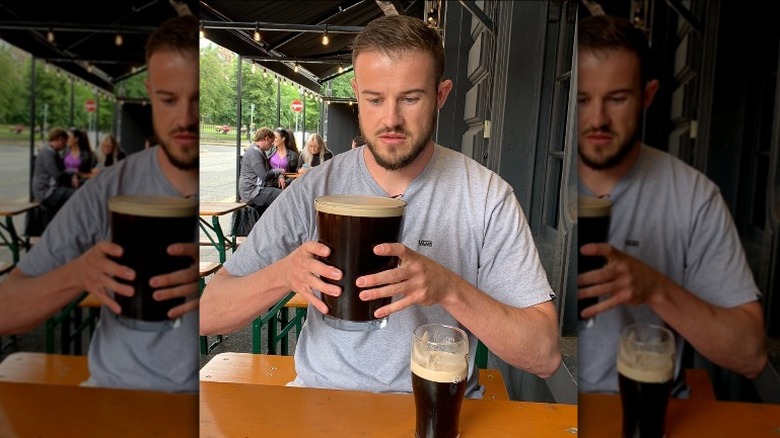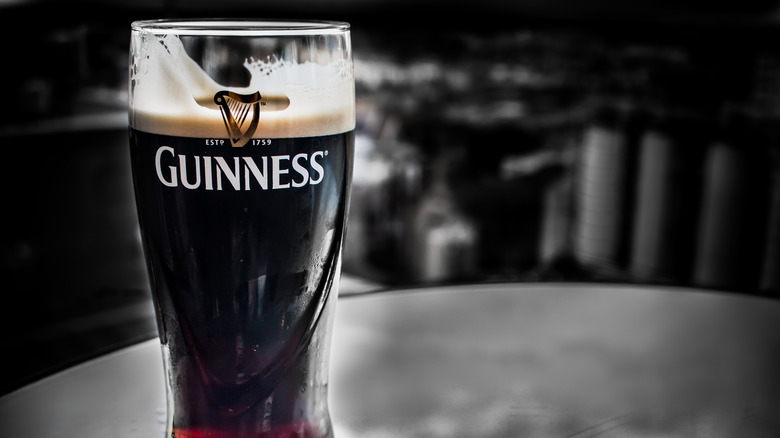Everything You Need To Know About Guinness
It's not unreasonable to assume that any establishment that sells beer has a tap for Guinness. The Irish stout founded over two centuries ago has sustained itself as a powerhouse in the industry and shows no signs of stopping anytime soon.
Guinness is so popular, in fact, that every single day an estimated 10 million pints of Guinness are enjoyed, per Best Beer HQ. Guinness records an annual sale of over 850 million liters, which correlates to 1.5 billion pints a year worldwide. Every St. Patrick's Day, an estimated 13 million pints of Guinness are served in 150 countries, a 150% increase in average sales (via Thrillist).
Everything about Guinness is recognizable. Its dark color, creamy head, harp logo, cascade effect when poured, and lovable toucan mascot all contribute to it maybe being the most iconic beer on the planet. Here is everything you need to know about the only stout you will ever need. Sláinte!
History of Guinness
The legendary beer brand was founded all the way back in 1759 on December 31, when Arthur Guinness took over a brewery located at St. Jame's Gate in Dublin. Guinness signed a 9,000-year lease on the then four-acre property, which was eventually bought out during expansion. Originally, Guinness did not brew the iconic stout it is now known for. It initially brewed ale, but once the beer market saw the growing demand for new style porters, Guinness steered the ship. By 1799, the Guinness brewery stopped brewing traditional ales completely and focused entirely on their dark beer.
In 1838, Guinness grew to become the largest brewery in Ireland and eventually became the largest brewery in the world in 1886, a title the brand still claims to this day. Today, Guinness is sold in over 150 countries and has operating breweries in 49.
You'll notice on any Guinness product, whether it be a can, tap, or other merchandise, a golden harp. This became the Guinness logo in the 1860s. As the stout became popular all across the globe, the brand wanted a symbol to distinctly identify Guinness as an Irish product. A harp was the obvious choice, as it is the official symbol of Ireland. In fact, because Guinness grew to be so recognizable, the Irish government actually had to flip their national emblem to face the other way to avoid trademark violation in 1922.
How is Guinness made?
The 200-year-old stout all starts with its malted barley, which is provided by barley farmers through a relationship spanning three generations. This barley is malted and crushed in mills before being mixed in with heated water taken from Poulaphouca Lake in County Wicklow. The mixture enters a kieve to be mashed, a process that separates the grain from the liquid, or sweet wort.
The barley is then roasted at a temperature of 232 degrees Celsius, which sits at the precise tipping point between not enough flavor and the barley burning. This roast is what creates the dark, ruby color of Guinness as well as the rich, toasty flavor. Next, Guinness actually adds twice as many hops as the average beer, a characteristic you may not recognize when taking a sip, but it's all about reaching a perfect balance of flavor.
Now, the wort cools before the addition of Guinness's yeast. This strain of yeast has been passed down generations and captures and emboldens all of the ingredients in every batch of Guinness. After the yeast ferments, each batch is matured for a brief period to relax before being tested by a Sensory Panel to ensure consistency and quality. One test includes the "head height" test, which certifies the number of bubbles in each pint, roughly 3,000,000.
You would think Guinness's taste is accomplished through some special technology or secret ingredients, but it's really just accomplished from quality ingredients, attention to detail, and passion for the craft.
What does Guinness taste like?
Answering this question requires being in a certain mindset and approaching a pint of Guinness as something in its own category. It would not be fair to describe Guinness's flavor and texture in comparison to any other beer, because Guinness is not like any other beer. Even other stouts or porters are fundamentally different. This does not mean that other beers are not as good as Guinness, because, of course, everyone has different tastes and preferences, but a pint of Guinness is not universal. It's something that varies depending on where you are in the world, how the bartender pours the pint, and how the keg of Guinness is taken care of.
Putting all of those variables aside, a proper Guinness will provide a full-bodied, well-balanced, pint with notes of roasted coffee and chocolate with a creamy mouthfeel and ever-smooth finish. The malted and roasted barley is definitely the most prevalent attribute, while the hops have more of a sweetness than bitterness, and are really only present to help round out the malt and shorten the finish. Again, each pint of Guinness is different, so for those who only like one certain type of beer or claim to not like beer in general, Guinness should not be considered for either, but looked at as something in its own category that you either like or don't like, but, when sipping with an open mind and appreciating Guinness for what it is, chances are you will.
How to drink Guinness
Guinness is readily available in cans at most liquor stores, but these packaged pints fail to represent the beauty of a correctly poured Guinness on draft. Unfortunately, there are bartenders who don't know the correct way to pour a Guinness but finding which spots do it best is undoubtedly a fun exploration.
If you have any Guinness experience, you may have heard of something called the "two-part pour." This is the recommended method of filling a pint glass with Guinness and has been around since the 1930s, per Keg Works. Then, Guinness was sold in two different types of casks, one highly conditioned and lower-conditioned. Bartenders were instructed to fill glasses with a certain combination of the two, but this convoluted process was eventually discarded in the 1950s with the introduction of nitrogen. However, the two-part pour remained.
This is because if you pour a Guinness in one go, the head is too big. Plus, pouring the Guinness partially, waiting, and topping it off provides each Guinness drinker the spectacle of the cascade effect we all recognize from the commercials.
According to Guinness, the proper way to pour a pint is to hold the glass at a 45-degree angle, fill it three-quarters (to the top of the harp), let it rest for one minute, 32.5 seconds, and then top it off sitting upright below the spout. Find yourself a bartender that performs this ritual, and you'll have a proper pint of Guinness handy.
Is Guinness expensive?
One of the best parts of Guinness is, despite its uniqueness and immense popularity, it remains a completely affordable beer no matter what form you enjoy it in. A pint at a bar will cost the same as any other average-priced beer on tap and if you do decide to try Guinness in a can, an eight-pack will only cost you around $15.
It should be mentioned that buying a pack of canned Guinness does have its place in the culinary world. You can certainly pour it into a glass and drink it if that's your thing, but having cans of Guinness at home can actually contribute to a wide variety of food dishes. Guinness's rich, roasty flavor is a great addition to things like stews, barbecue rubs, or even beer cheese. Regardless of how you use it, if you do decide to buy Guinness at the store, you don't have to worry about spending a lot.
Guinness vs Murphy's
As previously mentioned, Guinness is really in its own category of drink. Any other stout is pretty much guaranteed not to taste anything like Guinness. This does not at all mean Guinness is the only good-tasting stout on the market, it just means that it's one of a kind.
Of all the other stouts out there, however, Murphy's is probably the most comparable. Founded in 1856, Murphy's Irish Stout is owned by Heineken and is brewed at the Murphy's Brewery in County Cork, a county that boasts and prides itself on its production of both Murphy's Irish Stout and Beamish Draught Irish Stout. This stout is also a dry stout, which is determined by its use of roasted barley, but the flavor of Murphy's is sweeter than Guinness, with not as much emphasis on the malt.
Murphy's is more of a medium-bodied beer, whereas Guinness carries a full body. Guinness is definitely a more accessible beer. As mentioned earlier, Guinness can be bought in pretty much any place that sells beer. Murphy's, on the other hand, is not as commonly found, especially in the U.S. All in all, Murphy's is definitely not a "bad" beer, but it certainly doesn't hold a candle to the mighty Guinness.
Story of the toucan
If you've ever been to an Irish pub and looked around to notice the decor on the walls, you've most definitely seen a toucan with a pint of Guinness on its beak. You then probably wondered what Guinness and toucan have to do with one another.
Well, the advertisement featuring the exotic bird dates back to the 1930s, when a London-based advertising firm hired John Gilroy, an artist, to create a Guinness ad featuring a family drinking the beer, according to USA Today. Samples were reviewed but no one could agree on what the family should look like. Soon thereafter, Gilroy went to the circus with his son where he saw a sea lion balancing a ball on his nose. He drew an ad including the animal doing the same with a pint of Guinness and the ad became successful. This led to the firm using different animals in Guinness ads, including bears, kangaroos, ostriches, and pelicans, but it was the toucan that sustained.
Gilroy ended up using the toucan in a series of America-targeted ads in the 1950s that featured the toucan flying alongside landmarks such as the Golden Gate Bridge, Mound Rushmore, and the Empire State building. Nowadays, you can find the toucan on the walls of most pubs balancing its trademark pint always reminding you any day is a "lovely day for a Guinness."
Old-style glass vs new-style
Many Guinness drinkers believe the stout is best served in a Guinness-branded glass. For decades, that meant the classic, tulip-shaped glass with the Guinness name and harp logo pressed on. In 2012, the "gravity glass" was introduced, much to the disapproval of devout Guinness drinkers, according to The Irish Independent.
This new release was part of a trend followed by large companies to release officially licensed products in which to enjoy their product. The newer glass is embossed with curves running up it that mimic the pattern of the harp emblem. The harp is also embossed on the glass, but this feature, according to a Dublin pub-owner asked about the new release at the time, creates extra bubbles during the pour. In fact, one pub in County Kerry delegated most of the new glassware sent to them for the garbage. Either that, or they were given away to tourists as a souvenir.
Of course, the actual taste of Guinness does not vary depending on what type of glass it is poured into, but if you order a pint of Guinness and it is served to you in the old-style glass, you may just enjoy it that little bit more.
Guinness in Africa
Outside of Ireland and the United Kingdom, the popularity of Guinness may be assumed to spike in American cities with large Irish-American populations, or maybe a country like Australia that's home to many Irish descendants, but it turns out the continent of Africa is the biggest consumer of Guinness outside the Emerald Isle.
The Guinness shipped to Africa is labeled as "Guinness Foreign Extra Stout," and the beer's conquest began in 1803, per Smithsonian Magazine. When Arthur Guinness's son took over the brewery at St. Jame's Gate. he expanded the brand's distribution to England, Barbados, Trinidad, and Sierra Leone. By the 1860s, Guinness made its way down to South Africa, as local brewers across the continent established partnerships with the brand and began bottling the stout. As rebellions against colonization struck down the British Empire, Guinness remained. When Nigeria finally won its independence in 1960, the very first Guinness brewery outside Ireland or the UK opened in the nation's capital of Lagos. Nowadays, many Nigerians consider Guinness to be their national beer. Foreign Extra Stout is even brewed to better please the African palate. Instead of using barley, it is brewed with maize or sorghum, two crops traditionally brewed by African farmers.
Guinness's popularity in Africa goes far beyond Nigeria, however. In fact, Guinness consumption in the continent made up 35% of total sales, becoming the second largest market for the stout worldwide. Since then, consumption of Guinness in Africa has risen an estimated 13% each year.
You can soon live inside the Guinness brewery
It's true. Guinness is currently undergoing a project that will result in the St. Jame's Gate brewery in Dublin being transformed into a modern, urban neighborhood. Guinness's parent company, Diageo, and real estate developed, Ballymore, agreed to plans for the project that include over 300 apartments, two acres of parks, an entertainment venue, a food hall, a hotel, and commercial spaces.
Ambitions for the "Guinness Quarter" are quite large. Barry O'Sullivan, Diageo's managing director in Ireland, said he wants the new neighborhood to become one of the "most dynamic neighborhoods in Europe." The timeline for the project is expected to be done within the next decade, with the overall goal being to refurbish and preserve historical structures as well as create a new and vibrant place to live and visit. This balance between old and new will be a pretty fine line to walk, but those in charge believe that this venture being successful could usher in a new era of commerce and culture.
Guinness Guru
If you're ever fortunate enough to pay a visit to Ireland or the UK, a pint of Guinness should be on your itinerary. The fresher the pint, the better, so there is really no place on earth with as many opportunities for top-tier Guinness as these places. You have to make this one count, and with so many pubs to choose from, a little guidance can go a long way. Enter, the Guinness Guru.
Daragh Curran is a YouTuber who travels across Ireland and the UK to find the best pint of Guinness in any given city. The 28-year-old with nearly 47 thousand subscribers asks his audience which spots have the best Guinness in the city he's traveling to next. He will then visit the top five requested pubs, try their pint, and give each of them a rating out of 10. The Guinness Guru has visited counties all across Ireland, including Killarney and Galway as well as British cities like Glasgow, Manchester, and Belfast.
If all Guinness seems to taste the same to you, the Guinness Guru can help you note the characteristics that can vary and are worth considering. Trademark terms like "schtick" or "domage" all contribute to each score, in addition to temperature, pouring method, head size, and overall taste. Over 250 reviews have been done, but it looks as though the Guinness Guru is only just getting started, so give the channel a subscription and learn the in and outs of a proper pint.
Split the G
Another way you can enjoy your pint of Guinness like a true Irishman or woman is with this fun task. A common challenge in Ireland and the UK is to try and do something called "splitting the G." This means to drink your Guinness to the point where the bottom of the head falls in the middle of the letter "g" in the Guinness logo on the glass with your first sip (via To Europe and Beyond).
To take the task even further, finishing your entire pint in just four gos is the true Guinness challenge. The first sip must sit the head at the middle of the Guinness font, the second to the beginning of the glass's tapering, the third to the mid-point between there and the bottom, and the last until no stout remains.
Obviously, there are no concrete requirements for drinking a Guinness. Drinking it however you like at your own pace does not make you a wannabe Guinness drinker, but challenging yourself and your friends to "split the G" is just an interesting, fun challenge to share and start your pint with a little extra levity.
